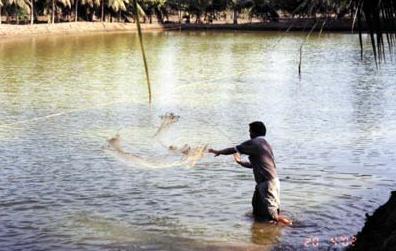|
Harvesting and Handling
Successful harvesting can be achieved if the shrimp can be harvested in good condition
within a short period of time. The harvesting technique should not damage or excessively
contaminate the shrimp with waste. Rapid harvesting will reduce the risk of bacterial
contamination and the shrimp will still be fresh when reaching the processor.
Complete harvesting can be carried out by draining the pond water through a bag
net and hand picking. The average culture period required is around 120-150 days
during which time the prawns will grow to 20-30 gm size (depending on the species).
It is possible to get two crops in a year. Harvested shrimps can be kept between
layers of crushed ice before transporting the consignment to market.
Methods of Harvesting
Two methods of harvesting are generally practiced on farms. These are either by
draining the pond and catching the shrimp in a bag net or by netting the shrimp
within the pond.
For the first method of harvesting, ponds and outlets should be appropriately designed
and be able to completely drain the pond within 4-6 hrs. A bag net should be able
to be fixed to the outlet to collect the shrimp that are carried by the out flouring
water. The best time for harvesting is early in the morning and it should be completed
before mid-morning. In ponds that can only be drained at low tide, the harvest should
be conducted whenever possible. The shrimp should be regularly removed from the
harvesting bag in small quantities to prevent damage.
When netting the shrimp within the pond, either a small electric net or a large
seine net can be used. The water level of the pond should be reduced to 0.5-0.75
m deep and workers will need to go inside the pond for netting. This method is less
advantageous the pond bottom will be disturbed, thus causing contamination of the
shrimp. It is also slower and may take a long time to complete.
With either method, it is necessary to hand-pick the remaining shrimp in the pond,
after the pond is drained. The harvested shrimp can be quickly killed by giving
them a temperature shock (dip in iced water) to prevent damage and to improve storage.

Cast netting of Shrimps
Timing of Harvesting and Selling
The timing of harvesting depends on the condition of the shrimp in the pond and
also the market price. Shrimps are sampled by a cast net from different areas of
the pond to determine their average body weight and general condition. The proportion
of soft shell shrimp should not be more than 5% at the time of harvest. This proportion
could be obtained by scheduling the harvest halfway between two moultings. The time
of moulting is indicated by the presence of exuviae in the pond. For example if
the average body weight of the shrimp is 30 gm, then the harvest should be planned
for 7-8 days after the exuviae are observed, as the next moulting cycle can be observed
after 14-16 days. Harvested shrimp should be iced and transported to cold storage
or processing plants in less than 10 hrs.
Top
|